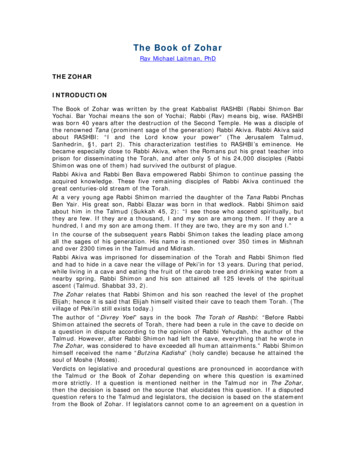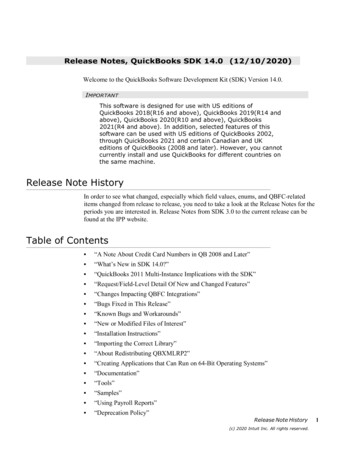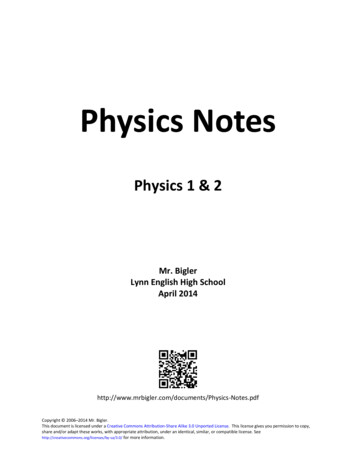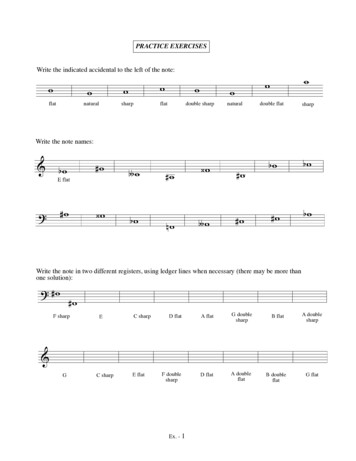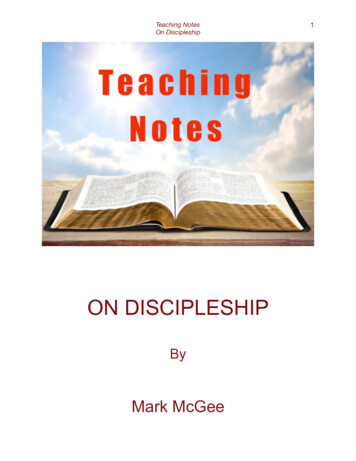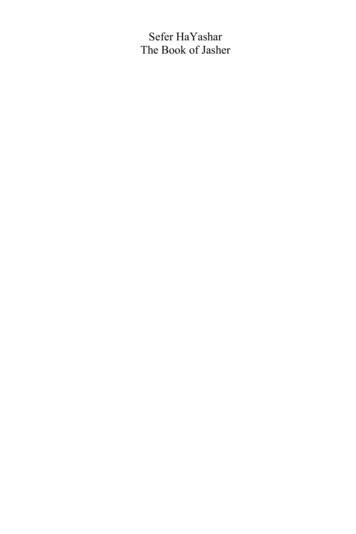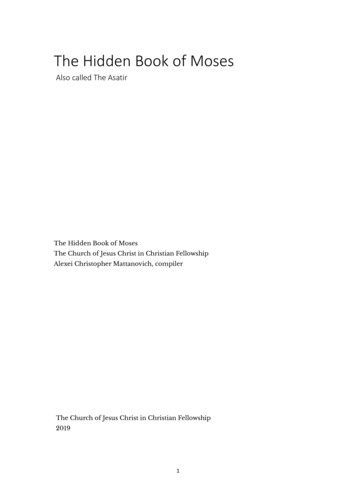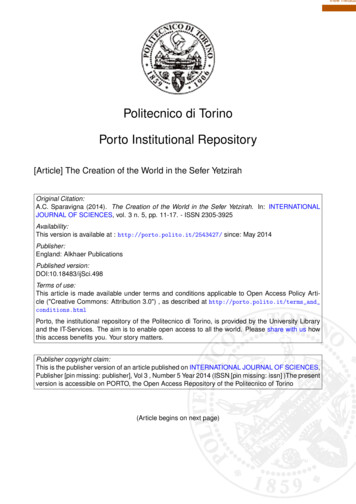
Transcription
20222Notes on Editions of Sefer Yetzirah in EnglishDon Karr Don Karr, 1991, 1994; updated 2001-2017; revised 2018-2022. Email: dk0618@yahoo.comAll rights reserved.License to CopyThis publication is intended for personal use only. Paper copies may be made for personal use.With the above exception, no part of this publication may be reproduced or transmitted in any form or by anymeans, electronic or mechanical, including photocopy, without permission in writing from the author.Reviewers may quote brief passages.Know that the principle of all kabbalah is included in these two issues mentioned in the Sefer Yeṣirah,the first of them is knowledge of the ten sefirot and the second is knowledge of the twenty-two letters.The one who receives should try to receive the sefirot first in order to receive the divine overflow[shefa] from them and in themselves according to his attributes [middot]. He will cleave to each andevery sefirah separately and he will cleave to all the sefirot together as one so that he will not cut theshoots.—Abraham Abulafia, Gan Na’ul1The Book of Creation (Sefer Yesira) is a unique, isolated work that belongs to no school of thought —Daphne Hadas Freedman2Sefer Yetzirah (BOOK OF FORMATION, hereafter SY) is the oldest known speculative treatisein Hebrew. There are three prime recensions of SY: (1) short, (2) long, and (3) onesomewhere in between called the Sa’adian recension in that it was the basis of Sa’adiahGaon’s commentary of the early tenth century.3 Even the longest of these containssomething less than 2500 words.The date of SY’s composition remains a matter of some debate, though most scholars agreethat it was written or compiled between the second and sixth centuries. However, Steven M.Wasserstrom has offered a strong case for the ninth century within an Islamic milieu. 4 It1Translation: Elliot R. Wolfson, Abraham Abulafia – Kabbalist and Prophet: Hermeneutics, Theosophy and Theurgy (LosAngeles: Cherub Press, 2000), page 109 [my brackets]. Compare Wolfson’s rendition with the less proficient translation ofthe same paragraph in Gan Naoul – Locked Garden, edited by Fabrizio Del Tin ([n.p.]: eUniversity.pub, 2018), page 11.Gan Na’ul is one of three commentaries on Sefer Yetzirah by Abraham Abulafia. See below, page 31.2This is the opening clause of Freedman’s article, “The Book of Creation,” in Kabbalah: Journal for the Study of JewishMystical Texts, vol. 44, edited by Daniel Abrams (Los Angeles: Cherub Press, 2019), pp. 159-168. Freedman compares SY tothe Introduction to Arithmetic of Nichomachus of Gerasa [c. 60-c. 120 CE] and the Theology of Arithmetic, attributed toIamblichus [c. 245-c. 325 CE].3Ithamar Gruenwald, “A Preliminary Critical Edition of Sefer Yezirah,” in Israel Oriental Studies 1 (1971); A. PeterHayman, “Introduction,” Sefer Yesira: Edition, Translation and Text-Critical Commentary (Tübingen: Mohr Siebeck, 2004).Sa’adiah “did not regard the Sefer Yezira as a divine, eternal, unchangeable text” (—Joseph Dan, “Three Phases of theHistory of the Sefer Yezirah,” in Jewish Mysticism, Volume I, LATE ANTIQUITY [Northvale – Jerusalem: Jason Aronson Inc.,1998], p. 165). “Thus, he felt free to edit the text and even omit lines that were offensive to his concepts.” (—ibid)Aryeh Kaplan adds a fourth recension: the GRA/ARI version; see below, Part III. C.1
20222was certainly extant by the tenth century, for it exerted a great influence on speculative andmystical thought from that time on.Commenting on SY at the AJS Conference of 2001, Elliot R. Wolfson stated, “Properlyspeaking, the work should not be described as a single composition, but rather as a compositeof distinct literary strands that have been woven together through a complicated redactionalprocess whose stages are not clearly discernable.”4Within a substantial (42-page) paper,5 Ronit Meroz offers some original hypothesesconcerning SY’s composition and meaning. Meroz advances (quoting the ABSTRACT at thehead of the article),1) the assertion that a single subject unites all the discussions in Sefer Yezirah, frombeginning to end: namely, the nature of Wisdom, upon which the world stands 2) a stylistic-linguistic analysis leading to the division of Sefer Yezirah into three “accounts,”around which are crystallized the style and contents of the book as a whole. The Accountof the “Sealing of the Ends” is the latest of these accounts and was written by the editorof the book who joined his account with the other two to form a single book.3) the assertion that the worldview reflected in Sefer Yezirah acknowledges the existence of asecondary power alongside God, that assists Him in the Creation and ongoing existenceof the universe (as against doctrines claiming the existence of an additional force inconflict with God).In a paper presented to the European Association for Jewish Studies (Paris 2014), “Some NewObservations Concerning the Context of Sefer Yetsirah,” Tzahi Weiss concludes,[I]t is possible to understand the singularity of Sefer Yetsirah in two opposing manners: thefirst is to understand it as a unique composition that had evolved in a known Jewishenvironment, whose authors or editors succeeded in dispersing most of its identifying Jewishsigns. The second possibility is to understand it as a treatise which does not in any way wantto conceal its cultural context but rather that this context is unknown to us its readers andinterpreters. Since Sefer Yetsirah employs many terms physiological, linguistic, astrological,cosmological and others in order to clarify its various arguments, there is no apparent reasonto believe that there is any attempt at concealing involved in this text. It therefore seems thatit would be more correct to support the possibility that the singularity of Sefer Yetsirah in the4The comments of both Steven M. Wasserstrom and Elliot R. Wolfson were made as discussants at the Association forJewish Studies 33rd Annual Conference (Washington, DC: December 16, 2001), Session 2.4: “Sefer Yesirah: Mystical andPhilosophical Intertexts,” Chair: Sarah Pessin.See Wasserstrom’s (1) “Sefer Yesira and Early Islam: A Reappraisal” in The Journal of Jewish Thought and Philosophy, vol.3, no. 1 (Chur/Philadelphia: Harwood Academic, 1993); (2) “Further Thoughts on the Origins of Sefer yesirah,” in Aleph:Historical Studies in Science and Judaism, N0. 2, edited by Gad Freudenthal (Bloomington: Indiana University Press, 2002)pages 201-221, (at JSTOR, http://www.jstor.org/stable/40385480?seq 1#page scan tab contents); and (3) Between Muslim andJew: The Problem of Symbiosis under Early Islam (Princeton: Princeton University Press, 1995), pages 126-133.Refer to Wolfson’s summary, SEFER YETZIRAH: LINGUISTIC MYSTICISM AND COSMOLOGICAL SPECULATION, which is asection of “Jewish Mysticism: A Philosophical Overview” CHAPTER 19 of History of Jewish Philosophy, edited by Daniel H.Frank and Oliver Leaman (London – New York: Routledge, 1997), pages 450-498 (the SY section covers pages 463-466).5“Between Sefer Yezirah and Wisdom Literature: Three Binitarian Approaches in Sefer Yezirah,” in Journal for theStudy of Religions and Ideologies, volume 6, number 18 – ESSAYS IN HONOR OF MOSHE IDEL (Cluj: University of Cluj-Napoca,Winter 2007), pages 101-142—online at http://www.jsri.ro/.2
20222eyes of its readers and interpreters evolves from an estrangement in regard to the culturalcontext in which its essential foundations evolved.6Joseph Dan describes three phases in the reception of SY7:1.an inexplicable dormant phase from its composition in the fourth century to the tenthcentury; while it was known, it was not the basis of doctrine or commentary.2. the philosophic or rational/scientific phase beginning in the tenth century whenspeculation on SY burgeoned, commencing with the commentaries of Shabbatai Donnolo,Sa’adiah Gaon, Donash ben Tanim, etc.3. the mystical/magical phase which began in the twelfth century with the AshkenaziHasidim, the Unique Cherub Circle and the Iyyun school, then passing to the Provençaland Catalonian kabbalists.Tzahi Weiss has proposed a seventh-century composition date for SY, within ChristianSyria. Further, he believes that SY was already considered a magical/mystical text withinDan’s first two phases, though he acknowledges the noticeable lack of references to SY in theperiod Dan calls the “dormant phase.”8Almost all versions of SY have six chapters containing brief, even laconic, statements,similar in tone to the hekhalot texts.9 It was from the first chapter of SY that kabbalah derivedthe term sefirot and the notion of these as metaphysical stages of creation. The remainingchapters of SY tell of the powers and correspondences of the twenty-two Hebrew letters.In 1971, Ithamar Gruenwald noted,Although Sefer Yezira is one of the most frequently published works of Jewish esoteric lore,there is no authoritative text available to those who want to study the book. To make a longstory short, there are at least three main recensions of the book, and except for one recension(the so-called Saadian recension) all the printed texts are defective.10Gruenwald was commenting on the state of editions in Hebrew, the inadequacies of whichwould inevitably be reflected—if not compounded—in any translation.In 2004, armed with a more complete array of textual witnesses, many of which were notavailable to Gruenwald in 1971, A. Peter Hayman produced Sefer Yesira: Edition, Translationand Text-Critical Commentary,11 which is the most thorough scholarly treatment of the SY textin English to date. The core of Hayman’s book is a synoptic edition of SY in Hebrew andEnglish, offering specific MS versions of the three recensions in a manner similar to Schäfer,Schlüter, and Mutius’ treatment of hekhalot texts in Synopse zur Hekhalot-Literatur.126Accessed via Academia.edu (12/17/2014):https://www.academia.edu/9805922/Some New Observations Concerning the Context of Sefer Yetsirah7Joseph Dan, “Three Phases of the History of the Sefer Yezirah,” cited above, page 1. note 3.“Sefer Yesirah” and Its Contexts (Philadelphia: University of Pennsylvania Press, 2018); see below, page 23.89101112It is interesting to note that, while the hekhalot literature takes up cosmology and cosmogony, reference to SY isentirely—and remarkably—absent therein. Ref. Joseph Dan, “Three Phases of the History of the Sefer Yezirah,” p. 160.In the introduction to “Preliminary Critical Edition .”Tübingen: Mohr Siebeck, 2004.Tübingen: J. C. B. Mohr [Paul Siebeck], 1981.3
20222Because of its importance and, no doubt, because of its brevity, SY has been put into Englishmany times. All of the English translations of SY which I have seen—and a few that Ihaven’t—are discussed in PART I A-B: TRANSLATIONS. This disparate collection is dealt within chronological order, starting with the fairly well-circulated translation of Isidor Kalisch(1877) and concluding with the stark translation of Avi Solomon (2021).4
20222PART I A: TRANSLATIONS: 1877 – 1952Kalisch, Isidor. ספר יצירה - Sepher Yezirah: A Book on Creation; or the Jewish Metaphysics ofRemote Antiquity, with English Translation, Preface, Explanatory Notes and Glossary (NewYork: L. H. Frank & Co., 1877; reprinted San Jose: AMORC, 1948, with several reprinteditions following; reprinted Berkeley Heights/Gillette: Heptangle Books, 1987 & 1990, in adeluxe edition; more recently, [2002 onward], reprinted in paperback and Kindle formats.)Kalisch gives a straightforward translation, showing the English and Hebrew side by side.His notes clarify the ideas and language of SY, often referring to readings from majorcommentaries and other rabbinic works. The publisher’s forward in the AMORC editionsays, “The service Dr. Kalisch rendered in 1877 by his first English translation of the SepherYezirah has grown ever greater with the passing years. Other translations, it is true, have acertain merit; none the less, none has surpassed and few have equaled the work which hedid.” This comment was written in 1948, but one could have made a case to fully concur untilrelatively recently (i.e., until Kaplan’s SY published in 1990, then Peter Hayman’s in 2004).13Kalisch translated what appears to be the long version.14 The work is free of any sort of occultagenda—a feature which plagues many of the editions discussed hereafter.A translation of SY was published in 1883 (2nd edition, 1886) in Alfred Edersheim’s ambitiousLife and Times of Jesus the Messiah (London – Bombay: Longmans/Green and Company, 2volumes; reprinted 1906; reprinted in recent years as a single volume by several publishers:Wm. B. Eerdmans Publishing Co., 1943 through 1981; MacDonald Publishing and WorldBible Publishing Company in 1994; Hendrickson Publishers in 1993 and 1997; reprintedfrequently in paperback and Kindle editions.)The SY translation appears in Appendix V, § 4. After a perfunctory description of kabbalah,which concludes, “ the book Yetsirah is the oldest Kabbalistic document,” the text of SY issummarized.The translation itself is qualified: “ not only the meaning of the expressions but even theirtranslations, is in controversy. Hence, not unfrequently, our rendering must be regarded asour interpretation of the mysterious original.” The translated text is then given in italics,with notes, bracketed or parenthetical words, and explanatory remarks in regular type. Whatwe get is an earnest effort at translation based on a rather terse version of SY (which, for1314See Jonathan D. Sarna, “Isador Kalisch’s Pioneering Translation of Sepher Yetzirah (1877) and Its Rosicrucian Legacy,”in Kabbalah in America: Ancient Lore in the New World, edited by Brian Ogren (Leiden – Boston: Brill, 2020), pages 138144.The short version, thought by some to be representative of the original text, begins (chapter 1, paragraph 1),Thirty-two mysterious ways has the Lord, Lord of Hosts, ordained through Scribe, Script, and Scroll.(from Phineas Mordell’s translation)By contrast, the long version immerses this simple line in a stream of biblical epithets:In Thirty-two paths of wisdom did Yah, Lord of hosts, God of Israel, the living God, king of the universe,God almighty, merciful, gracious, exalted, Who dwells in an eternity of holiness, holy is His name, create Hisuniverse by three enumerations: number, word, and script. (from a partial translation of my own)Further, with this first paragraph we run into complications with the last several words, which are rendered differentlyby each translator. Kalisch has “by three Sepharim, namely: 1) S’for; 2) Sippor; and 3) Sapher,” leaving thesetransliterated in the text to then be explained in his notes. The anonymous Guild Press edition (see below, page 12)ends Mishna Aleph (i.e., paragraph 1), “He creates His world in three forms, In letter, in number, in sound.”5
20222instance, omits the “predominations” of the letters from chapter 4). The notes and additionsare more helpful than intrusive, and where he is unsure, Edersheim nobly places a questionmark next to his variant renderings.Westcott, William Wynn. Sepher Yetzirah. The Book of Formation and the Thirty-two Paths ofWisdom, translated from the Hebrew (Bath: Robert H. Fryar, 1887; 2nd revised edition:London: Theosophical Publishing Society, 1893; 3rd edition: London: J. M. Watkins, 1911;reprinted New York: Samuel Weiser, 1975; reprinted San Diego: Wizards Bookshelf, 1990[this edition adds notes from Mme. Blavatsky’s works]. “Fourth Revised edition, withHebrew text”: Volume 3 of Darcy Kuntz’ GOLDEN DAWN STUDIES SERIES [Edmonds:Holmes Publishing Group, 1996]. Westcott’s SY is also included in a reprint of CollectanæHermetica, a series which Westcott edited 1893-1911 [Weiser, 1998]. Westcott’s SepherYetzirah was also reproduced in The Sacred Books and Early Literature of the East, VOLUMEIV: Medieval Hebrew: The Midrash, The Kabbalah [Charles F. Horne, contributing editor],New York – London: Parke, Austin, and Lipscomb, 1917.)Westcott was an occultist who, with S. L. M. Mathers, was a founding member of theHermetic Order of the Golden Dawn. Both Westcott and Mathers put several magical andmystical texts into English in the late 1800s and early 1900s. Most pertinent to Kabbalah areMathers’ Kabbalah Unveiled (sections of the Zohar after the Latin of Knorr von Rosenroth)and Westcott’s SY, which, in spite of the claim on the title page that the work was“translated from the Hebrew,” appears to have been totally dependent on a Latin version.Arthur E. Waite, in his introduction to the Stenring translation (discussed below), says ofWestcott’s SYIt is based on the text of Rittangelius, compared with some other versions. It was prepared forthe use of persons described as theosophists, occult and Hermetic students, whose purpose – ifany – may have been served by such a production, but is in reality a paraphrase and fulfillsfew of the conditions required by scholarship.Although there is a bit of the pot calling the kettle black in Waite’s comments, they do give afair appraisal of Westcott’s work.Along with SY, Westcott offers an English translation of The Thirty-two Paths of Wisdom; itsinclusion is not explained, nor is the text introduced. From other sources (Waite’sintroduction to Stenring for one), we learn that The Thirty-two Paths is a late addition to SY,appended in some Latin versions. In a series of short paragraphs, it tells of the intelligences,powers and virtues of the thirty-two paths, which are the ten sefirot plus the twenty-twoletters of the Hebrew alphabet.Westcott’s connections with the Hermetic Order of the Golden Dawn afford his treatmentof SY a certain pedigree—at least in the eyes of those who involve themselves with GoldenDawn teachings and literature; thus, it has been reprinted far more often than any otherversion and appears at a large number of sites on the Internet.Papus [Gerard Encausse]. The Qabalah: Secret Tradition of the West (French original, Paris:1892. English translation, London and New York: Thorsons and Samuel Weiser, 1977.)Even though the original, La Cabbale tradition secrète de l’Occident, is in French, Papus’ work isincluded here because it offers an SY translation (of sorts) by an influential occultist which6
20222has been circulating in English for some time. Unfortunately, one finds Papus’ treatment ofSY (pages 203-48 in the Weiser edition) in the midst of a pseudo-scholarly mess. The entirebook is a confusion of elements, Jewish and non-Jewish, many having no connection withkabbalah at all. There are many astounding errors, and the reader is flogged with a continualmystery mongering.As for the SY section, Papus introduces the text with a verbose and meandering forwardfollowed by an utterly superfluous summary of the text. Finally, there is the text, full ofbizarre renderings. Papus gives the three sefarim (SY 1:1) as “number, numbering, andnumbered.” He uses E to represent the Hebrew letter aleph in one place, only to use it torepresent heh in another. He renders heh-qoph as OCH, and for the Tetragrammaton, yod-hehvav-heh, he puts YOAH, then IOAH, and later IEVE. To the usual six chapters of SY, Papussaw fit to add a seventh, consisting of a redundant list of correspondences, an account of thederivatives of the letters, and a general résumé. Papus follows SY with not only The Thirtytwo Paths of Wisdom but also The Fifty Gates of Understanding. The Fifty Gates is a hierarchiclist of features of the universe; Papus’ version is derived from Athanasius Kircher’s ŒdipusÆgyptiacus (3 volumes, Rome: 1652-5). Papus’ section on SY concludes with an essay, “TheDate of the ‘Sepher Yetzirah’” by Dr. Sair A. C. which advances the notion that SY is fromthe patriarchal age or earlier on the basis that scholars have not proven otherwise—at leastnot to the satisfaction of subscribers to the occult tradition.15Davidson, P[eter]. The Sepher Jetsirah or Book of Formation, to which is added THE THIRTYTWO WAYS OF WISDOM and THE FIFTY GATES OF INTELLIGENCE, translated an annotatedby P. Davidson (Louisville, White County [GA]: Peter Davidson / Glasgow [Scotland]:Bernard Goodwin, 1896).Davidson’s work is mentioned on page 30 of Gershom Scholem’s Kabbalah among theEnglish translations of SY. Given the time and place of this publication—Louisville: 1896—the author is most certainly Peter Davidson (1837-1915), one of the prime movers of theHermetic Brotherhood of Luxor.16I have not seen Davidson’s SY except for scans of the cover, preface, and first page of thetext and annotations, all kindly provided by Philip Smith (9/17/2016), who, I believe, aptlydescribes Davidson’s production as having an “occult agenda.”Mordell, Phineas. The Origins of the Letters and Numerals According to the Sefer Yetzirah (“Thepresent thesis appeared in the Jewish Quarterly Review, New Series for April 1912 vol. II, andfor April 1913 vol. III. Published by Dropsie College Philadelphia Pa.” SUPPLEMENT: “A1516Papus’ rendering of eser sefirot belimah (a phrase which opens a series of statements in SY, chapter 1) is “The tenSephiroth, excepting the ineffable.” It must be conceded that the meaning of belimah or beli mah is open to speculation.Gershom Scholem discussed some of the possible meanings in Origins of the Kabbalah (page 28):According to some views, the obscure word belimah, which always accompanies the word sefirot, is simply acomposite of beli mah – without anything, without actuality, ideal. However, judging from the literal meaning,it should be understood as signifying “closed,” that is, closed within itself.Further, see Peter Hayman’s comments in “Some Observations of Sefer Yesira (1) Its Use of Scripture,” (Journal ofJewish Studies 35:2 [1984]) concerning belimah, where he mentions its likely derivation from JOB 26:7.In her article, “Between Sefer Yezirah and Wisdom Literature” (in Journal for the Study of Religions and Ideologies, v. 6,no. 18 – Winter 2007, page 103), Ronit Meroz develops the idea that “the sefirot are themselves the belimah.”Refer to Godwin, Chanel and Deveney, The Hermetic Brotherhood of Luxor (York Beach: Samuel Weiser, Inc., 1995), inparticular pages 22-32.7
20222Solution of the Pythagorean Number Philosophy.” “Copyright 1922 by Phineas Mordell.”Reprinted, New York: Samuel Weiser, 1975.)Mordell’s thesis regarding SY contains notions which are difficult to credit: the Sefer Yetzirah, as the earliest Hebrew grammar, contains the fundamental rules ofHebrew orthography . according to the Sefer Yetzirah, there are ten double letters, and not only seven, as isbelieved by all commentators since Saadya.In spite of the numerous works written on Hebrew orthography since the beginning of thetenth century, there is not one which may be considered as really based on the Hebrew [onwhich the SY is based].Many more troubling statements could be quoted; however, I shall leap to Mordell’sconclusion:Already Abraham Abulafia perceived that the Pythagorean number philosophy is identicalwith the Sefiroth philosophy of the Sefer Yetzirah. The relation they bear to each other isvariously explained. A. F. Thimus shares the view that the Pythagorean philosophy is anadaptation from the Sefer Yetzirah. Others hold that the author of Sefer Yetzirah borrowedhis philosophy from Pythagoras and Plato. Would it be to [sic] bold to conclude that SeferYetzirah represents the genuine fragments of Philolaus?Mordell develops his thesis further in a supplement, “A Solution of the Pythagorean NumberPhilosophy,” which is included in the Weiser reprint of The Origin of the Letters and Numerals.Mordell put his English translation and the Hebrew of SY side by side, but his version isunlike any which I have ever seen, especially in chapter 1, paragraph 3, where Mordell’stranslation reads, “The ten double letters are ” (the italics are mine). All other readings andtranslations put the number of double letters of the Hebrew alphabet at seven.17Stenring, Knut. The Book of Formation (Sepher Yetzirah) by Rabbi Akiba ben Joseph including the 32 Paths of Wisdom, their correspondences with the Hebrew alphabet and theTarot symbols, with an introduction by Arthur Edward Waite (Philadelphia: DavidMcKay Co., 1923; reprinted New York: Ktav Publishing House, 1970; reprinted with aforeword by R. A. Gilbert, Berwick: Nicolas-Hays, 2004).Stenring refers to his own work as a “word-for-word translation from the Hebrew.” He useda number of SY texts to construct his version. Those parts of the text which Stenringconsidered “genuine” are printed in ordinary type; those parts which he considered“spurious” are printed in italics. Thus, with Stenring we find the first attempt—in English, atany rate—to separate the long version’s supposed additions from the short version’spresumed original text while presenting both. Stenring supplemented the text with a longsection of notes concerning the language of SY, citing numerous alternative readings. Healso constructed several charts and tables based on the information in SY.17It is puzzling that, out of all the possible translations, David Meltzer chose Mordell’s quirky rendering to represent SYin The Secret Garden: An Anthology in the Kabbalah (New York: The Seabury Press, 1976). Alas, this is not the onlydoubtful aspect of Meltzer’s well-circulated compilation.8
20222Stenring’s work on SY seems careful and conscientious, but there are some disquietingstatements here and there. A paragraph from the notes section serves well as a summaryexample:The 231 GatesEighteen hundred years ago, when Rabbi Akiba ben Joseph reduced into writing the secrettradition of the Jews in the “Book of Formation,” he hesitated to unveil the greatest secret ofthe Kabala, the Arcanum of the Great Symbol, which had been handed down to him from hisforefathers. For this reason he embodied it in a riddle (“S.Y.,” II. 4 and 5), which manyancient and modern philosophers have tried in vain to solve. Of all the different tabulations,claiming to be the Great Arcanum of the Kabala, that we have examined, none is correct. Thetoken of the original table ONG and NGO was not to be found in any of them. We havesucceeded in solving this riddle. The true Kabalistic Symbol the Great Master Key to thetheoretical and practical Kabala will be found facing p. 24 of the present translation.[The diagram faces page 21 in the Ktav edition.]In his introduction to Stenring’s book, A. E. Waite diffuses Stenring’s claims somewhat:They [those who consider Stenring’s diagram] will come at least across many curiouspermutations and will be in agreement with myself that the elaborate Diagram is ofconsiderable interest, from whatever point of view it is approached, and however they mayinterpret Mr Stenring’s statement that absolute knowledge of a single number is “impossiblefor a human mind” (p. 37), unless it has opened every Gate of Understanding, i.e., hasacquired “an encyclopedic knowledge of all sciences.”Waite’s introduction to Stenring is generally pretty good, though limited by his dependenceon Christian sources. He gives a fair account of SY: its background, editions, and content.Stenring also includes The Thirty-two Paths of Wisdom, saying that histabulation of Paths and their titles will be given according to Comtesse Calomira de Cimara(from her French translation of 1913), and the translation of the tract according to Waite andWestcott.18Comment: Israel Regardie on The Thirty-two Paths of Wisdom:It seems to me, after prolonged meditation, that the common attributions of theseIntelligences is [sic] altogether arbitrary and lacking in serious meaning.(—A Garden of Pomegranates, London: Rider and Co., 1932, introduction, p. iv)Hall, Manly Palmer. The Secret Teachings of All Ages. An Encyclopedic Outline of Masonic,Hermetic, Qabbalistic and Rosicrucian Symbolical Philosophy (San Francisco: H. S. CrockerCo., 1928; “Golden Anniversary Edition, Reduced Facsimile,” Los Angeles: ThePhilosophical Research Society, 1978; SY section [pages 114-16] reprinted by Lamp ofTrismegistus, 2020)Hall states that he used Kalisch’s translation as the “foundation” of his “interpretation” ofSY, but that “material from other authorities has been incorporated and many passages havebeen rewritten to simplify the general theme.” He consulted a number of other versions ofSY, two of which have been discussed above: Westcott’s and Stenring’s. Hall relied heavily18Waite’s version of The Thirty-two Paths can be found in The Holy Kabbalah, pages 213-219.9
20222on Western occult sources, some of which, such as the works of Mme. Blavatsky and EliphasLevi, are notoriously capricious.Doreal, Dr. M[aurice]. Sepher Yetzirah. The Book of Creation. The Kabbalah Unveiled. A Verseby Verse Analysis (Sedalia: Brotherhood of the White Temple, 1941.)The second paragraph of Dr. M. Doreal’s foreword reads,The “Sepher Yetzirah” or “Book of Creation” is usually traced back to the Sixth Century,though it is much older, being, in fact, one of the earliest of the traditional teachings.According to legend, it has existed since the beginning of the world; and it is a record and keyto that beginning. Adam was supposed to be its first author; and it was believed to be therecord of the lost wisdom of the Pre-Adamic races.Doreal’s typescript is illustrated by fold-out charts of THE TWENTY-TWO LETTERS and THEEMANATION OF THE TWENTY-TWO LETTERS, along with numerous diagrams through thetext. His treatment betrays the influence of Mme. Blavatsky, Wynn Westcott, and S. L. M.Mathers.Dyer, Roberta Coldren. The Sepher Yetzirah (The Book of Formation): A Treatise on the SecretScience of Christhood as Presented in the Qabalistic Doctrines of the Hebrews and the Traditions ofthe Egyptians: charts original (Evanston: Omen Press, 1949).My sincere thanks to Paty and the Special Collections staff at the University of California.Santa Barbara Library for providing a photocopy of Dyer’s title page.Raskin, Saul. Kabbalah in Word and Image, with the Book of Creation and from the Zohar (NewYork, Academy Photo Offset, Inc., 195
The Book of Creation (Sefer Yesira) is a unique, isolated work that belongs to no school of thought —Daphne Hadas Freedman2 Sefer Yetzirah (BOOK OF FORMATION, hereafter SY) is the oldest known speculative treatise in Hebrew. There are three
